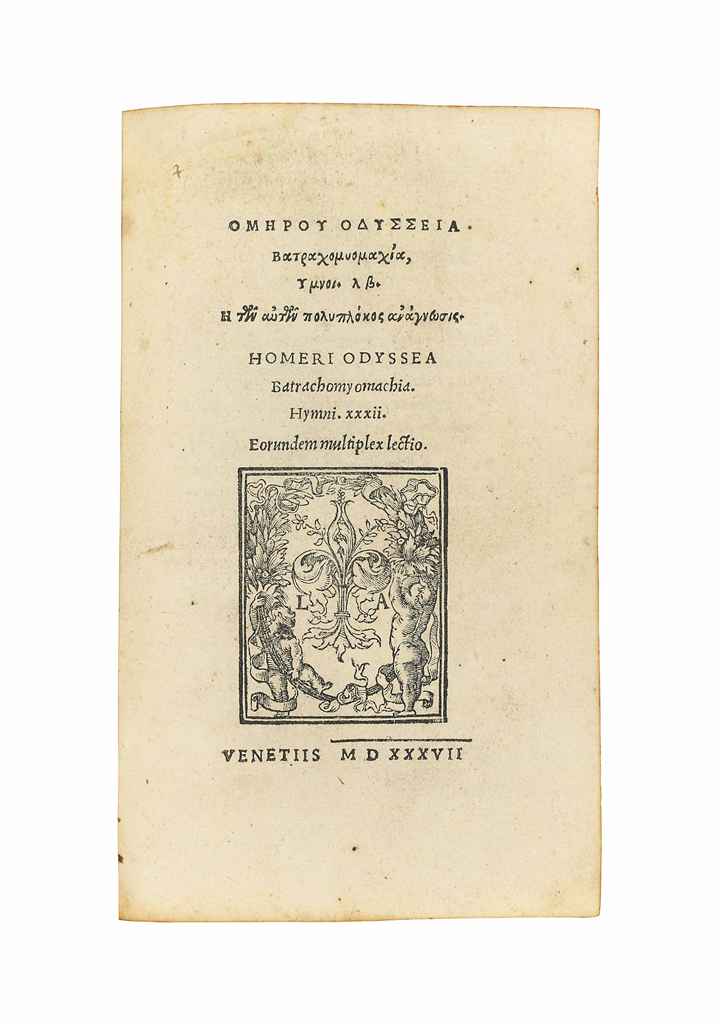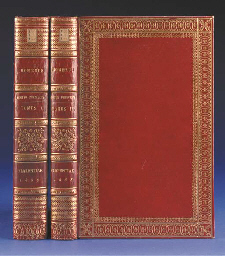HOMER (?8th century B.C.). Opera , in Greek. Edited by Demetrius Chalcondylas. Florence: [Printer of Vigil (C 6061), perhaps Bartolommeo di Libri, and] Demetrius Damilas for Bernardus and Nerius Nerlius (with the financial support of Giovanni Acciaiuoli), 9 December 1488 [but not published before 13 January 1488/89, date of the dedication]. 2 volumes, median 2 (305 x 216mm). Collation: [volume I:] A-D 8 E 1 0 (A1r Bernardo Nerli's dedicatory letter to Piero de' Medici in Latin, A1v editor's preface in Greek, A3r Herodotus's life of Homer, B1r Plutarch's life of Homer, E7v Dio Cassius's oration on Homer, E9v-10 blank); 2A- 2Z ET 8 8 (Iliad). 249 leaves (of 250; without blank E10). [Volume II:] AA-ZZ 8 ETET 6 (AA1r Odyssey, XX2r Batrachomyomachia, XX6r Hymns to Apollo, ETET5v colophon in Greek, ETET6 blank). 189 leaves (of 190; without final blank), 2A4-6, 2B2-7 and 2C 8 misbound after A2. Types: text 121Gk (recast by Damilas on a larger body, with the addition of a few sorts, from the same matrices as Paravisinus type 1:117 Gk), dedication 96R (Di Libri type 1), signatures 110R (Printer of Benignus type 1). 39 lines. 10- and 2-line initial spaces, the first two initials supplied in red. (Washed, some staining, 2A1 and 8 cut down and window-mounted (from another copy) with loss of some letters, A1-2 with marginal worming, small wormhole in final quire of vol. I, 2A3, 7, 8, 2B1.8 trimmed at fore-edge and possibly inserted from another copy, first few quires repaired at hinge, damp in vol. II resulting in paper weakness strengthened in a number of leaves, repairs in about 10 leaves with some loss of text.) Modern brown morocco panelled in gilt and blind by Bernard Middleton, red edges. Provenance : extensive early interlinear translations and marginal annotations in Latin and Greek through vol. I, quire I. EDITIO PRINCEPS of all texts, with the exception of atracomiomacia which was printed earlier in a Greek-Latin edition. THE MOST IMPORTANT FIRST EDITION IN GREEK CLASSICAL LITERATURE. Earlier castings of Homer type, the design of which may have been modelled on Michael Apostolis's script (see Barker, Greek Script & Type p. 28-31), had been used by Damilas and Paravisinus for Lascaris's rvthmata(Milan: 1476), the first book printed entirely in Greek, and by Bonus Accursius for his first editions of Aesop and Crastonus. For the complications in trying to find an existing Florentine printing shop, which Damilas and the Nerli brothers might have employed for their Homer -- the most ambitious Greek production until the Aldine Aristotle -- see Proctor ( Printing of Greek p. 66-69) and R. Ridolfi ( La Stampa in Firenze nel secolo XV ch. 7). In his preface Chalcondylas describes the corrupt state of the manuscripts used for the texts of Homeric Hymns and Batrachomyomachia . Copy-text for the epics was more adequate and he adds that in order to decide corrections of uncertain readings he worked his way through Eusthatius's monumental 12th-century commentary. HCR 8772; BMC VI, 678 (IB. 27657 and 27657a-c); Goff H-300; IGI 4795; CIBN H-173; Flodr, Homerus 1; PMM 31. (2)
HOMER (?8th century B.C.). Opera , in Greek. Edited by Demetrius Chalcondylas. Florence: [Printer of Vigil (C 6061), perhaps Bartolommeo di Libri, and] Demetrius Damilas for Bernardus and Nerius Nerlius (with the financial support of Giovanni Acciaiuoli), 9 December 1488 [but not published before 13 January 1488/89, date of the dedication]. 2 volumes, median 2 (305 x 216mm). Collation: [volume I:] A-D 8 E 1 0 (A1r Bernardo Nerli's dedicatory letter to Piero de' Medici in Latin, A1v editor's preface in Greek, A3r Herodotus's life of Homer, B1r Plutarch's life of Homer, E7v Dio Cassius's oration on Homer, E9v-10 blank); 2A- 2Z ET 8 8 (Iliad). 249 leaves (of 250; without blank E10). [Volume II:] AA-ZZ 8 ETET 6 (AA1r Odyssey, XX2r Batrachomyomachia, XX6r Hymns to Apollo, ETET5v colophon in Greek, ETET6 blank). 189 leaves (of 190; without final blank), 2A4-6, 2B2-7 and 2C 8 misbound after A2. Types: text 121Gk (recast by Damilas on a larger body, with the addition of a few sorts, from the same matrices as Paravisinus type 1:117 Gk), dedication 96R (Di Libri type 1), signatures 110R (Printer of Benignus type 1). 39 lines. 10- and 2-line initial spaces, the first two initials supplied in red. (Washed, some staining, 2A1 and 8 cut down and window-mounted (from another copy) with loss of some letters, A1-2 with marginal worming, small wormhole in final quire of vol. I, 2A3, 7, 8, 2B1.8 trimmed at fore-edge and possibly inserted from another copy, first few quires repaired at hinge, damp in vol. II resulting in paper weakness strengthened in a number of leaves, repairs in about 10 leaves with some loss of text.) Modern brown morocco panelled in gilt and blind by Bernard Middleton, red edges. Provenance : extensive early interlinear translations and marginal annotations in Latin and Greek through vol. I, quire I. EDITIO PRINCEPS of all texts, with the exception of atracomiomacia which was printed earlier in a Greek-Latin edition. THE MOST IMPORTANT FIRST EDITION IN GREEK CLASSICAL LITERATURE. Earlier castings of Homer type, the design of which may have been modelled on Michael Apostolis's script (see Barker, Greek Script & Type p. 28-31), had been used by Damilas and Paravisinus for Lascaris's rvthmata(Milan: 1476), the first book printed entirely in Greek, and by Bonus Accursius for his first editions of Aesop and Crastonus. For the complications in trying to find an existing Florentine printing shop, which Damilas and the Nerli brothers might have employed for their Homer -- the most ambitious Greek production until the Aldine Aristotle -- see Proctor ( Printing of Greek p. 66-69) and R. Ridolfi ( La Stampa in Firenze nel secolo XV ch. 7). In his preface Chalcondylas describes the corrupt state of the manuscripts used for the texts of Homeric Hymns and Batrachomyomachia . Copy-text for the epics was more adequate and he adds that in order to decide corrections of uncertain readings he worked his way through Eusthatius's monumental 12th-century commentary. HCR 8772; BMC VI, 678 (IB. 27657 and 27657a-c); Goff H-300; IGI 4795; CIBN H-173; Flodr, Homerus 1; PMM 31. (2)















Testen Sie LotSearch und seine Premium-Features 7 Tage - ohne Kosten!
Lassen Sie sich automatisch über neue Objekte in kommenden Auktionen benachrichtigen.
Suchauftrag anlegen